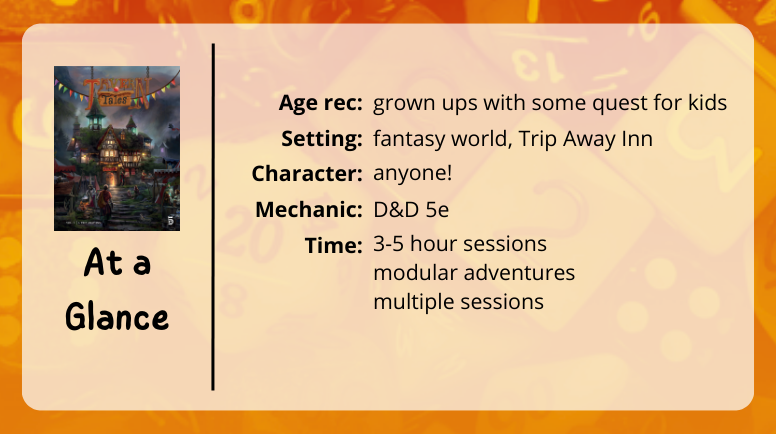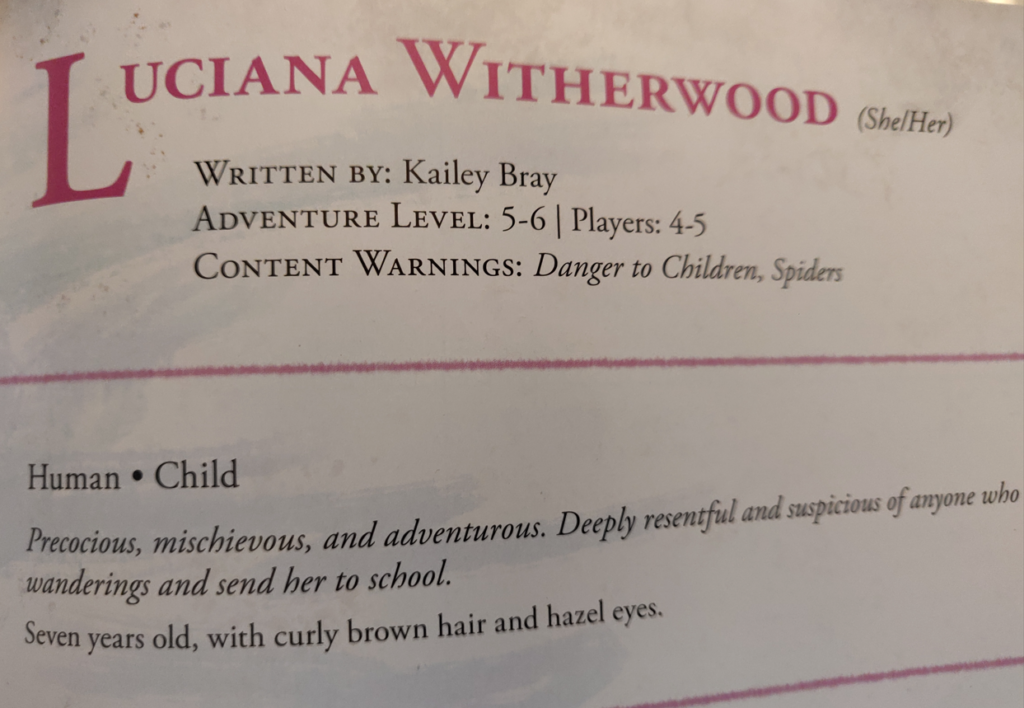Review of the Luciana Witherwood adventure in Tavern Tales, plus a highlight on helpful TTRPG tools
Note: This post may contain affiliate links. At no additional cost to you, I may earn a small commission from purchases made using them. TTRPGkids uses this to keep the site going. Read full disclosure here.
Jump to:

Tavern Tales has adventures for grow-ups but Luciana Witherwood is great for 8+
Tavern Tales contains a lot of content that I would recommend only for grown ups, however, it is REALLY easy to see which parts these are because they’ve taken a lot of care to list trigger warnings on every adventure (and I’ll highlight this later in the mechanics as a feature that’s needed more in TTRPGs for kids). You can parse out which adventures are OK for your players or not without having to read the whole section.

The Luciana Witherwood adventure, however, would be GREAT for kids about ages 8+ (D&D mechanics are generally recommended for 8+ due to complexity). The Luciana adventure focuses on exploration, RP, and solving traps and puzzles with some combat popping up here and there but no serious peril, gore, mature themes, or NPC death (the antagonist may get turned into a paper puppet, but it’s clearly stated they can escape and aren’t dead).
Other content in the book, like the circus that comes to town, offers a lot of all-ages friendly activities as well, like carnival rides and games, getting to see baby owlbears, and being able to run your own market stall, that can be taken into games with kids and used as a base for other adventures.
While many adventures in the book are for grown-ups, I think there’s also a lot to be generally learned from the tools and aids used to identify triggers, use symbols for important info, and more… and I really like that the Luciana adventure is just as exciting and eventful as every other adventure while also being accessible to younger players. It’s a good side-by-side for anyone wanting to create stories for any age.
Tavern Tales is set in a medieval fantasy world
Tavern Tales revolves around players picking up missions from NPCs at the Trip Away Inn, which works well for running modular quests and rotating out players. There’s a circus in town, and LOTS of interesting characters searching for aid, including Luciana!
For Luciana’s quest, you’ll be helping this strong-willed 7 year old find her parents who, a few days before, she wished would disappear…. And then they did! There’s plenty to discover, NPCs to investigate, and several locations to explore, including a very fun-house of chaotic challenges. This adventure is absolutely filled with traps, puzzles, and magical chaos.
Your character in Tavern Tales

Your character in Tavern Tales is a D&D character that you’ve created who is there to pick up quests and help out with jobs around town, whether it be through altruism, in pursuit of reward, or another incentive.
One unique character element that’s added above and beyond D&D is that there’s a new class to go along with the circus themes in the book: The Owlbear Tamer! There’s rules for your owlbear buddy to level up alongside your character, and I think this would be a really cool class to offer for kids to play (there is a very common theme in my games with kiddo and in talking to others about games with their kids that they adopt every creature they can).
Mechanics in Tavern Tales
Tavern Tales runs on D&D, so I won’t go into D&D mechanics, however, there’s some additional elements that Tavern Tales uses that I want to highlight because, while they are being using in a game book for general audiences, they would be GREAT to also apply in more games for made specifically for kids.
Trigger warnings listed up front on every adventure
First, Tavern Tales, has a list of potential triggers right under the title for every adventure so you can see what the content is immediately before reading on.
For the Luciana adventure, the content warnings are “danger to children” and “spiders”, which I can go over ahead of time with kiddo.

Then, I might see that the only warning for the Sinessio Bravo quest is “alcoholism”, so it might be OK to review for 8+, depending on the kids, or could be easily tweaked to take out that one particular element from the story.
Then I also see that the Izak Lot adventure includes “gore” and “murder”, among other things, so I know right away that it would be a grown-ups only kind of quest for my planning purposes.
For a book with lots of variety in the adventures, this is really important to quickly see what kind of content there is BEFORE you read (versus the GM needing to read ahead of time and having to face their own triggers without warnings).
This is also really important in TTRPGs adventures that are made specifically for kids too, and many creators sort of assume that since their adventure doesn’t include combat, there’s not going to be triggers. I’ve found lots of kid-friendly and all-ages focused games that do include triggers, like storms, spiders, natural disasters, etc that aren’t marked and can be concerning for kids, even if they aren’t combat-focused. I’m a bit guilty of it too (especially with some of my solarpunk themed games, there’s a lot of environmental hazards that I don’t call out ahead of time), so I think Tavern Tales is a good example for creators to learn from..
Pictures and icons on challenges and stat blocks
Tavern Tales also uses a lot of picture-based markers to identify what type of challenge is being faced (i.e. every section is marked with a symbol for trap, combat, etc to make them easily identifiable for the GM), and stat blocks have really clear symbols to quickly find AC, HP, and SPEED.
I’m a huge fan of using symbols, in addition to words, to hone in on key elements, and these modifications or tools really help from a GM standpoint to quickly find important information without having to parse through blocks of words first. It’s another element of Tavern Tales that I think can be a great model for other games.
Overall thoughts on Tavern Tales and the Luciana Witherwood adventure
When I first cracked open Tavern Tales, I was honestly a bit concerned about reviewing only a single adventure in such a big adventure book that was not all kid-friendly, but, the more I got into it, the more I saw how it is actually put together with a lot of care towards different triggers, player interests, and more so that there’s still something for any age in here.
I would say that Tavern Tales is not necessarily all-ages focused, but it’s wide-ages focused – it has a large variety of tolerances that it can be used with, and it makes sure to clearly mark everything so that a variety of GM’s and players can effectively use the book.
For the Luciana adventure specifically, I loved the chaos of the story, the variations in the challenges, and the spirit of the main NPC – it was a lot of fun, and I hope you all get to check it out as well!
Find a copy of Tavern Tales
You can find a copy of Tavern Tales here through DriveThruRPG or the Escape Plan Games website!
If you liked this post, make sure to subscribe to the TTRPGkids monthly newsletter to stay up to date on the latest reviews, tips and tricks, game and podcast list updates, and more! Thank you for playing tabletop RPGs with your kids and sharing this awesome hobby with the next generation!


